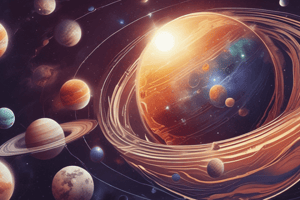Podcast
Questions and Answers
Which type of planet is characterized by being small and rocky?
Which type of planet is characterized by being small and rocky?
- Terrestrial Planet (correct)
- Ice Giant
- Gas Giant with Rings
- Gas Giant
What is the primary characteristic that defines a planet?
What is the primary characteristic that defines a planet?
- It is in orbit around the Sun (correct)
- It has a magnetic field
- It has moons
- It has a solid surface
What is the largest planet in our solar system?
What is the largest planet in our solar system?
- Uranus
- Saturn
- Jupiter (correct)
- Earth
Which planets have ring systems?
Which planets have ring systems?
Which of the following planets do not have a solid surface?
Which of the following planets do not have a solid surface?
What is the primary characteristic of an Ice Giant?
What is the primary characteristic of an Ice Giant?
Which of the following planets have a strong magnetic field?
Which of the following planets have a strong magnetic field?
What is a characteristic of Terrestrial Planets?
What is a characteristic of Terrestrial Planets?
Flashcards are hidden until you start studying
Study Notes
Planets
Definition
- A planet is a celestial body that:
- Is in orbit around the Sun
- Has sufficient mass to assume a hydrostatic equilibrium shape (i.e., it is nearly round in shape)
- Has cleared the neighborhood around its orbit
Types of Planets
- Terrestrial Planets: small, rocky planets with a solid surface
- Examples: Mercury, Mars, Earth
- Gas Giants: large, gaseous planets with no solid surface
- Examples: Jupiter, Saturn
- Ice Giants: large, icy planets with a thick atmosphere
- Examples: Uranus, Neptune
Characteristics of Planets
- Size: ranges from Mercury ( smallest) to Jupiter (largest)
- Composition: varies from rocky to gaseous to icy
- Atmosphere: some planets have a thin atmosphere, while others have a thick one
- Temperature: ranges from extremely cold to extremely hot
- Moons: some planets have many moons, while others have none
Planetary Features
- Rings: some planets have ring systems, made up of ice and rock particles
- Examples: Saturn, Jupiter, Uranus, Neptune
- Magnetic Fields: some planets have a strong magnetic field, which protects them from solar winds
- Examples: Earth, Jupiter, Saturn
- Mountains and Volcanoes: some planets have geological features, such as mountains and volcanoes
- Examples: Earth, Mars
Planets
Definition
- A planet must orbit around the Sun, have sufficient mass to be nearly round in shape, and have cleared the neighborhood around its orbit.
Types of Planets
- Terrestrial planets are small, rocky, and have a solid surface, with examples including Mercury, Mars, and Earth.
- Gas giants are large, gaseous, and have no solid surface, with examples including Jupiter and Saturn.
- Ice giants are large, icy, and have a thick atmosphere, with examples including Uranus and Neptune.
Characteristics of Planets
- Planet size ranges from Mercury (smallest) to Jupiter (largest).
- Planet composition varies from rocky to gaseous to icy.
- Atmospheres of planets range from thin to thick.
- Temperatures of planets range from extremely cold to extremely hot.
- Moons of planets vary in number, with some having many and others having none.
Planetary Features
- Saturn, Jupiter, Uranus, and Neptune have ring systems composed of ice and rock particles.
- Earth, Jupiter, and Saturn have strong magnetic fields that protect them from solar winds.
- Earth and Mars have geological features such as mountains and volcanoes.
Studying That Suits You
Use AI to generate personalized quizzes and flashcards to suit your learning preferences.




